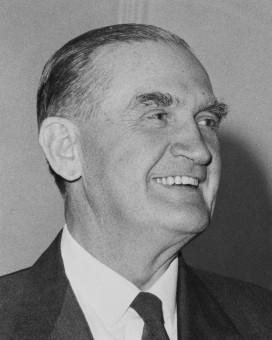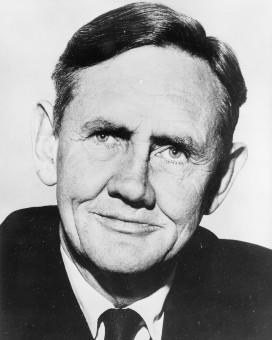15 September 1934
Harold Edward Holt unsuccessfully contested Yarra against James Scullin in this election. The United Australia Party won 28 seats to Labor’s 18, Lang Labor’s 9 and the Country Party’s 14, with South Australia’s Liberal and Country League winning 5 seats. The United Australia Party won 16 Senate seats and the Country Party won 2.
17 August 1935
In this by-election Holt won the seat of Fawkner, covering the Melbourne suburbs of South Yarra, Toorak, Prahran, Armadale and Windsor.
23 October 1937
The Lyons government was returned with 28 seats in the House of Representatives and Holt retained the seat of Fawkner. The Country Party won 16 seats and the Labor Party, led by John Curtin, won 29 seats. Labor also made gains in the Senate, winning 16 seats, while the United Australia Party won only 3.
21 September 1940
The United Australia Party, led by Robert Menzies after the death of Joseph Lyons in April 1939, narrowly retained government with the help of the Country Party. The United Australia Party won only 23 seats (and lost one when Arthur Coles declared himself an Independent) to Labor’s 32. The Country Party won 14 seats, Lang Labor 4 seats and there was 1 Independent. The United Australia Party and Country Party won 16 Senate seats, and Labor won 3.
21 August 1943
Holt retained Fawkner, though the United Australia Party, led by William Hughes, lost heavily. The Curtin Labor government increased its majority, winning 49 seats to 12 United Australia Party seats, 7 Country Party, 3 Country-National Party, 1 Victorian Liberal Country Party, 1 Queensland Country Party and 1 Independent in the House of Representatives. Labor won all 19 Senate seats contested. After this election, the United Australia Party elected Robert Menzies as leader.
28 September 1946
The Labor government of Ben Chifley won 43 House of Representatives seats. Robert Menzies’ new Liberal Party won 15 seats and the Country Party won 11 with the South Australian Liberal and Country League winning 2 seats, the Victorian Liberal Country Party 1, 1 Lang Labor and 1 Independent. In the Senate, the Liberal and Country Party alliance won 3 seats to Labor’s 16.
10 December 1949
Holt became the candidate for Higgins, a new seat carved out of his Fawkner electorate, after the size of federal parliament was increased. The House of Representatives expanded from 75 to 121 seats, and the Senate increased from 36 to 60 seats. The Liberal Party won 55 seats in the House of Representatives, the Country Party 19 and Labor 47. At this election, 42 Senate seats were contested, the Coalition winning 23 and Labor 19.
28 April 1951
In this double dissolution election, the Coalition government was returned with a reduced majority in the House of Representatives, but with control of the Senate. In the House, the Liberal Party won 52 seats to the Labor Party's 54, with the Country Party winning 17 seats. Of the 60 Senate seats, the Coalition won 32, Labor 28.
29 May 1954
In the aftermath of the defection of Soviet embassy officials Vladimir and Evdokia Petrov the month before, a federal election returned the Coalition government. The Liberal Party won 47 seats, the Country Party 17 seats and Labor 57 seats in the House of Representatives.
10 December 1955
The Coalition was returned with an increased majority, with 57 Liberal, 18 Country Party and 47 Labor seats in the House of Representatives. After the formation of an anti-Communist grouping split the Labor Party early in 1955, Prime Minister Robert Menzies had obtained an early dissolution of parliament, on the grounds of bringing together the elections for both Houses. In the half-Senate election, of the 30 seats contested, the Coalition won 16, Labor 12, Anti-Communist Labor 1 and Country-Western Australia 1.
22 November 1958
John McEwen replaced Arthur Fadden as leader of the Country Party and deputy Prime Minister in March 1958. At the November federal election, the Menzies–McEwen Coalition was returned with a substantial majority. In the House of Representatives the Liberal Party won 58 seats, the Country Party 19, and Labor 45. Of the 32 Senate seats contested, however, the Coalition and Labor each won 15. The other 2 seats were won by the Democratic Labor Party and Country-Western Australia. The 1958 election campaign was the first where television was widely used by the parties.
9 December 1961
At this election the Coalition narrowly retained government, with 45 Liberal and 17 Country Party seats to Labor’s 60. The Coalition thus governed by a majority of 1 seat after a Speaker was elected in the House of Representatives. Of the 31 Senate seats contested at this election, the Coalition won 15 and Labor 14, with 1 Country-Western Australia and 1 ‘other’.
30 November 1963
Menzies called this House of Representatives election early, and obtained an improved majority with 52 House of Representatives seats won by the Liberal Party, 20 by the Country Party, and 50 by Labor.
26 November 1966
The Liberal Party won 61 seats, the Country Party 21, and the Labor Party 41 with 1 Independent in this House of Representatives election. This was the largest parliamentary majority in 65 years. It was the only election in which Harold Holt stood for his seat as Prime Minister, and the last of the 14 federal elections he contested.

Press clippings kept by Prime Minister Harold Holt in the lead up to the 1966 election. NAA: A1728, 15, p.39
Sources
These brief election results relate only to this Prime Minister. They are drawn from the online sources below, where further information can be found.
Australian Electoral Commission: Election results
University of Western Australia: Australian Government and Politics Database





